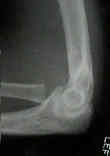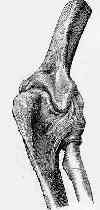Discussion

- descision to excise the head of the radius depends associated elbow injuries as well as severity of radial head frx;
- it has been determined that the stabilizing effect of radial head comes into play only when the MCL ligament has been disrupted, which
explains why excision of radial head (w/ no other injury) is not associatted w/ instability;
- valgus-varus alignment of the elbow can determine the pattern of force transmission thru the forearm;
- w/ valgus stress, the interosseous membrane plays a minimum role in force transmission;
- most of the force will be transmitted directly from the distal radius thru radial head - captiellar articulation;
- gripping activities which place a varus stress on the elbow do cause force transmission thru the interosseous membrane;
- w/ varus alignment, there will be minimal contact bewteen the radial head and capitellum;
- surgical indications:
- isolated type-III frx:
- treated w/ early complete excision;
- this method is preferred to simple removal of displaced fragments;
- early excision is more important for type-III frx than for type-II frx since success w/ delayed excision in type iii frx is unpredictable;
- w/ excision of radial head (and nl RU joint support), only approx 2 mm of proximal radial migration is expected;
- concomitant valgus instability: (due to MCL instability)
- consider replacement w/ Silastic or metallic radial head prosthesis in order to serve as temporary spacer after repair of MCL & flexor pronator mass;
- contraindications to excision:
- concomitant RU joint instability indicates a essex lopresti injury;

- Technique of Radial Head Excision;
- is safely carried out thru a posterolateral incision;
- most vulnerable structure to damage is PIN;
- do not extend incision more than 5 cm distal from epicondyle;
- note that the radial head is covered by a coalescence of the LCL and annular fibers;
- disruption of this complex during the radial head excision may lead to posterolateral instability;
- hence attempt to preserve the distal half of the ligamentous complex over the radial head as well as to keep the incision slightly anterior;
- Complications of Excision:
- proximal migration of radius;
- leads to positive ulnar variance;
- in about 15-20% of patients, there will be more than 1 mm of migration;
- migration more than 2-4 mm is associated w/ wrist pain;
- elbow pain may occur if the proximal radius abuts the capitellum;
- posterolateral elbow instability;
- Posterolateral Rotatory Instability of the Elbow Following Radial Head Resection.
- The Effect of Radial Head Excision and Arthroplasty on Elbow Kinematics and Stability.
Late results of excision of the radial head for an isolated closed fracture.
Results of delayed excision of the radial head after fracture.
Resection of the radial head for fracture of the radial head. Long-term follow-up of seventeen cases.
Biomechanical study of the elbow following excision of the radial head.
Vulnerability of the posterior interosseous nerve during radial head resection.
Symptomatic proximal translation of the radius following radial head resection.
Radioulnar load sharing in the forearm. A study in cadavera.
Symptomatic proximal translation of the radius following radial head resection.
Fractures of the Radial Head and Neck Treated with Radial Head Excision.
Posterolateral Rotatory Instability of the Elbow Following Radial Head Resection.
The Effect of Radial Head Excision and Arthroplasty on Elbow Kinematics and Stability.

